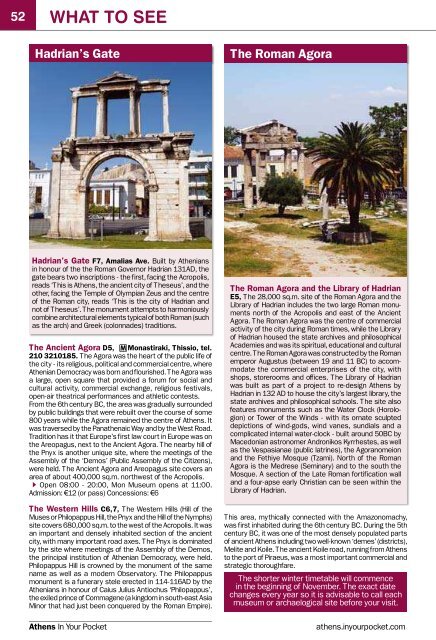IYP Athens Oct/Nov 2009 (6MB) - In Your Pocket GmbH
IYP Athens Oct/Nov 2009 (6MB) - In Your Pocket GmbH
IYP Athens Oct/Nov 2009 (6MB) - In Your Pocket GmbH
Create successful ePaper yourself
Turn your PDF publications into a flip-book with our unique Google optimized e-Paper software.
52<br />
whAt to see<br />
Hadrian’s Gate<br />
Hadrian’s Gate F7, Amalias Ave. Built by Athenians<br />
in honour of the the Roman Governor Hadrian 131AD, the<br />
gate bears two inscriptions - the first, facing the Acropolis,<br />
reads ‘This is <strong>Athens</strong>, the ancient city of Theseus’, and the<br />
other, facing the Temple of Olympian Zeus and the centre<br />
of the Roman city, reads ‘This is the city of Hadrian and<br />
not of Theseus’. The monument attempts to harmoniously<br />
combine architectural elements typical of both Roman (such<br />
as the arch) and Greek (colonnades) traditions.<br />
The Ancient Agora D5, MMonastiraki, Thissio, tel.<br />
210 3210185. The Agora was the heart of the public life of<br />
the city - its religious, political and commercial centre, where<br />
Athenian Democracy was born and flourished. The Agora was<br />
a large, open square that provided a forum for social and<br />
cultural activity, commercial exchange, religious festivals,<br />
open-air theatrical performances and athletic contests.<br />
From the 6th century BC, the area was gradually surrounded<br />
by public buildings that were rebuilt over the course of some<br />
800 years while the Agora remained the centre of <strong>Athens</strong>. It<br />
was traversed by the Panathenaic Way and by the West Road.<br />
Tradition has it that Europe’s first law court in Europe was on<br />
the Areopagus, next to the Ancient Agora. The nearby hill of<br />
the Pnyx is another unique site, where the meetings of the<br />
Assembly of the ‘Demos’ (Public Assembly of the Citizens),<br />
were held. The Ancient Agora and Areopagus site covers an<br />
area of about 400,000 sq.m. northwest of the Acropolis.<br />
QOpen 08:00 - 20:00, Mon Museum opens at 11:00.<br />
Admission: €12 (or pass) Concessions: €6<br />
The Western Hills C6,7, The Western Hills (Hill of the<br />
Muses or Philopappus Hill, the Pnyx and the Hill of the Nymphs)<br />
site covers 680,000 sq.m. to the west of the Acropolis. It was<br />
an important and densely inhabited section of the ancient<br />
city, with many important road axes. The Pnyx is dominated<br />
by the site where meetings of the Assembly of the Demos,<br />
the principal institution of Athenian Democracy, were held.<br />
Philopappus Hill is crowned by the monument of the same<br />
name as well as a modern Observatory. The Philopappus<br />
monument is a funerary stele erected in 114-116AD by the<br />
Athenians in honour of Caius Julius Antiochus ‘Philopappus’,<br />
the exiled prince of Commagene (a kingdom in south-east Asia<br />
Minor that had just been conquered by the Roman Empire).<br />
<strong>Athens</strong> <strong>In</strong> <strong>Your</strong> <strong>Pocket</strong><br />
The Roman Agora<br />
The Roman Agora and the Library of Hadrian<br />
E5, The 28,000 sq.m. site of the Roman Agora and the<br />
Library of Hadrian includes the two large Roman monuments<br />
north of the Acropolis and east of the Ancient<br />
Agora. The Roman Agora was the centre of commercial<br />
activity of the city during Roman times, while the Library<br />
of Hadrian housed the state archives and philosophical<br />
Academies and was its spiritual, educational and cultural<br />
centre. The Roman Agora was constructed by the Roman<br />
emperor Augustus (between 19 and 11 BC) to accommodate<br />
the commercial enterprises of the city, with<br />
shops, storerooms and offices. The Library of Hadrian<br />
was built as part of a project to re-design <strong>Athens</strong> by<br />
Hadrian in 132 AD to house the city’s largest library, the<br />
state archives and philosophical schools. The site also<br />
features monuments such as the Water Clock (Horologion)<br />
or Tower of the Winds - with its ornate sculpted<br />
depictions of wind-gods, wind vanes, sundials and a<br />
complicated internal water-clock - built around 50BC by<br />
Macedonian astronomer Andronikos Kyrrhestes, as well<br />
as the Vespasianae (public latrines), the Agoranomeion<br />
and the Fethiye Mosque (Tzami). North of the Roman<br />
Agora is the Medrese (Seminary) and to the south the<br />
Mosque. A section of the Late Roman fortification wall<br />
and a four-apse early Christian can be seen within the<br />
Library of Hadrian.<br />
This area, mythically connected with the Amazonomachy,<br />
was first inhabited during the 6th century BC. During the 5th<br />
century BC, it was one of the most densely populated parts<br />
of ancient <strong>Athens</strong> including two well-known ‘demes’ (districts),<br />
Melite and Koile. The ancient Koile road, running from <strong>Athens</strong><br />
to the port of Piraeus, was a most important commercial and<br />
strategic thoroughfare.<br />
The shorter winter timetable will commence<br />
in the beginning of <strong>Nov</strong>ember. The exact date<br />
changes every year so it is advisable to call each<br />
museum or archaelogical site before your visit.<br />
whAt to see<br />
The Parthenon Lysikrates Monument<br />
Parthenon E6, MAcropolis, tel. 210 3214172. Built<br />
between 447-437BC, during the ‘Golden Age’ of <strong>Athens</strong><br />
under Pericles, the Parthenon is a world famous sight.<br />
Its design harmoniously combines the Doric and Ionic<br />
orders, and its architectural and structural details and<br />
the precision in the carving of the marble are a testament<br />
to the expertise in the artisans that created it. Further,<br />
the décor of the Parthenon and its surrounding monuments<br />
had a profound and lasting influence on Western<br />
art (especially sculpture and portraiture), as it depicted<br />
the human form in an individualised manner for the first<br />
time. These artistic innovations fuelled developments<br />
that influenced the art of Hellenistic and Roman times,<br />
as well as the Renaissance, Baroque, Romanticism and<br />
Neoclassicism. QOpen 08:00 - 20:00. Admission: €12,<br />
Concessions: €6 (four day pass)<br />
Panathenaic Stadium<br />
Panathenaic Stadium H7, Arditos Hill, tel. 210<br />
3251744. A Stadium existed on this site from as early<br />
as the 4th century BC, when it was used for the mystical<br />
Ceremonies held for the Panathenaic Festival in honour<br />
of Athena, patron-goddess of the City of <strong>Athens</strong>. Roman<br />
governor Hadrian had also constructed a Stadium at this<br />
site, where gladiatorial contests and shows were put on for<br />
the Athenian public. The ancient Stadium was completely<br />
restored, as an exact replica of the Ancient Stadium, in the<br />
late 19th century, in order to host the first modern Olympiad<br />
(1896). During the <strong>Athens</strong> Olympic Games of 2004, this<br />
gleaming white Pentelic-marble Stadium provided the venue<br />
for the archery event as well as for the culmination of the<br />
Marathon Run. Visitors can walk up to the Stadium but are<br />
not allowed to enter its grounds.<br />
Lysikrates Monument F7, Lysicratous Square and<br />
Tripodon St, Plaka, MSyntagma. This monument commemorates<br />
the support of its benefactor-founder of a theatrical<br />
performance at the nearby theatre of Dionysus, the<br />
earliest theatre in the world - that’s the answer in case you<br />
wonder just what that strange structure on Tripodon Street<br />
is. It was built in 335BC by Lysicrates and is also known as<br />
the “Lantern of Diogenes” in reference to its unusual shape.<br />
The circular building rests on a square shaped limestone<br />
podium and includes a portico of six Corinthian columns.<br />
It also has a frieze featuring the life of Dionysos, the god of<br />
wine and revelry. <strong>In</strong> 1669, the structure was handed over<br />
to Capucin monks, who used it as a study room. The Lysicrates<br />
monument is the best preserved of its kind, mainly<br />
due to the efforts of French archaeologists Fr. Boulanget<br />
and E. Loviot who restored the area in 1887.<br />
Temple of Olympian Zeus<br />
Temple of Olympian Zeus F7, Vasilissis Olgas &<br />
Amalias, MAcropolis, tel. 210 9226330. Construction<br />
of the temple began in the 6th century BC under the tyrants<br />
Hippias and Hipparchos, at the site of the ruins of an earlier<br />
temple built by their father, the tyrant Peisistratus. The<br />
Temple stood unfinished throughout the ‘Golden Century’<br />
of <strong>Athens</strong> and was only completed by Roman governor Hadrian,<br />
known as the ‘Philhellene’, in 132AD. The Temple was<br />
huge by ancient standards, rivalling other colossal famous<br />
Temples such as the Heraion in Samos, and featured a large<br />
gold and ivory statue of Zeus in its cella. Today, only fifteen<br />
of its original 104 columns are still standing. A sixteenth<br />
column lies on the ground, where it fell during a storm in<br />
the 19th century. QOpen 08:00 - 20:00. Admission: €2,<br />
Free for pass holders.<br />
A four day pass costing €12 (concessions €6) will get you<br />
in: The Acropolis, the Ancient Agora & museum, Kerameikos<br />
& museum, the Roman Agora, Acropolis’ North<br />
& South Slopes and the Temple of Olympian Zeus.<br />
athens.inyourpocket.com athens.inyourpocket.com<br />
<strong>Oct</strong>ober - <strong>Nov</strong>ember <strong>2009</strong><br />
53







